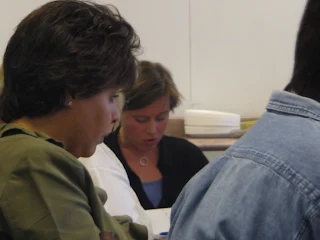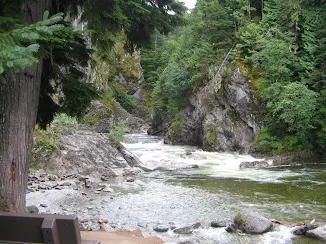Tuesday, September 30, 2008
Northern Gateway Pipeline - Ten percent equity for First Nations in Northern Gateway Pipeline Project
Wednesday, September 17, 2008
Host of contrasts on the coast
The coast is a host of contrasts and a primary one is cultural. For example, First Nations are people of the Potlatch who express a lot of national heritage in artistic endeavours that are indelibly cultural. The First Nations identify a presence and their communities with iconic art found in dozens of locations up the coast. When you come to see major features in First Nation art you are likely in the midst of a First Nation community.
Tourism travel on the coast leads visitors into adventurous activities like tours of whale and bear-watching that take people to places like Bute Inlet, Toba Inlet, Desolation Sound. And when you go farther north, tours take visitors into the Broughton Archipelago, Knight’s Inlet or Kingcome Inlet, or around the top of Vancouver Island. As a cultural exploration, Vancouver Island is but one of a seemingly countless number of islands, many of which were inhabited, while others were cultivated, and others were used for communal harvest of vegetation or wildlife.
It is surprising how many people lived in places no longer considered for habitation. In some of these places there are communities holding extinction at bay with one or two Band members living in remote locations like Hopetown or Gilford Island. At Kingcome Inlet, very top of the world when you are there, 125 souls keep a solid First Nation footprint on the ground (even though the houses are on stilts).
Victoria is a picturesque city full of art shops and museums often honed in on the First Nation culture of the Pacific Coast, but Victoria is a city. On the opposite side of the prominent Malahat from Victoria and still southerly on Vancouver Island is the city of Duncan, halfway point between Victoria and Nanaimo. Duncan is a great place to see the cultural contrast in full bloom. They call Duncan the City of Totems and there are totem poles set around the city but the main attraction is the Quw'utsun' Cultural and Conference Centre. It’s a re-created Salishan village nestled beside the Cowichan River and a beautiful representation of past and present Cowichan Tribes community.
The north end of Vancouver contains more rugged beauty enhanced by temperate weather, and the rainforest is more readily available to visit. Hiking, touring, fishing, and outdoor life continues on a year-round basis, top to bottom, on both sides of the big island, but when you arrive at the community of Alert Bay on Cormorant Island you could ask about visiting Yukusem where you will learn about the study of Culturally Modified Trees (CMT). This is the study of human beings working to organize around rainforest resources. What David Garrick, anthropologist, uncovered on Hanson Island is the 'transgenerational' management of vegetation by First Nations at the north end of the Inside Passage, and it is amazing.
This careful study of transgenerational management provides evidence that First Nations used forest resources in coastal rainforests in complex arrangements. Special preserves of rainforest under carefully defined jurisdictions were ‘managed’ to create and provide essential resources. Social groups conducted large scale horticulture within particular groves of cedar trees on Yukusem’s 16 square kilometres, doing so on a truly grand scale. Together they made cedar trees do the most incredible things horticultural.
David Garrick uncovered cedar-shaping in CMTs during his long and fruitful tenure of archaeology on-site at Yukusem. This amazing process involves planning that spans centuries. This cultivation was done in a manner that shaped trees and modified them to produce a surplus of bark while maintaining the integrity of a living cedar tree. First Nations maximized cedar bark production by modifying the tree, doing this in a way that left the cedar tree to heal, thrive, and produce more surplus bark. It was a strategy of development that occurred because cedar bark was a staple product in the social and economic development of coastal life. This cultural product was used in an apparently endless array of purposes. The practice to cultivate giant cedars was millennial to make trees produce a surplus cedar bark into a raw material for production of manufactured goods.
Nothing was left to chance or waste. The term old-growth forest was meaningless within a culture that practised continuous and specialized cultivation in the growth of the forests over several centuries. Even a burnt forest was an opportunity to harvest a different list of highly-prized resources. Meanwhile, everything on Yukusem was planned around the need to produce cedar bark for future generations. A prime example of the transgenerational planning policy occurs on a site called Bear Grove on Yukusem. Garrick’s mapping points out the existence of at least 55 shaped cedars per hectare in the Bear Grove sector of the island. This is an intense concentration of evidence indicative of creating surplus bark. It becomes obvious from concentrations of CMTs of this magnitude that an organized effort was made to cultivate and exploit cedar bark in patterns showing sustainable, long-term, transgenerational planning processes.
The people of Yukusem living 1,350 years ago cultivated a specific tree to furnish Namgis carver Beau Dick with raw material for his canoe project in the modern age. Also in this transgenerational context, ancient people provided a modern chain of evidence to Harry Alfred and Don Svanvik, CMT researchers from Alert Bay who are able to exert First Nation jurisdiction over Yukusem cedar groves in the present. The vital (and heretofore missing) evidence was produced from messages in trees hundreds of years old. The fingerprints of this interaction with forests have been uncovered in many of the forests of B.C., even so, it was a long and arduous 20th century for the folks around Yukusem. Only in 2004 did the First Nations recover jurisdiction over Yukusem.
CMTs studied in this way by Garrick provided scientific resources and evidence to give First Nations proof of former jurisdiction. It is interesting to note, however, there was no apparent conflict in the management of Yukusem resources until about 1930, Garrick explains. His archaeological time-line shows that before the cataclysmic culture shock treatments took form (residential schools, banning of potlatchs, et al), the arrival of industrial foresters was a not-unwelcome event to a degree. The industrial foresters were cooperative by taking only a few trees from Yukusem’s treasured groves, and Garrick reports they apparently left cedar trees untouched, cedar was for the cedar shapers those who used it as a specially-managed and treasured resource. Thus Garrick has proven how two management paradigms co-existed!
It required an exercise of federal government policy to alienate First Nations from their management and jurisdiction over cedar shaping activities. From the time such government policies were introduced until Yukusem Heritage Society was formed in 2004 the cedar groves on Hanson Island faced dire circumstances. Garrick’s archaeological study was the one thing standing in their way, and in a pleasant turn since his study began a series of scientific facts have freed people to exert their sovereignty.
“I am the land and resource officer of the Namgis First Nation,” said Harry Alfred, one afternoon in a communal garden on Yukusem. Alfred described how people have rebounded because of Garrick’s work in these groves. Cultural energy burst from the CMT research and in a way people have regained a sense of cultural balance. New community energy has been born from the old secrets. Alfred and Don Svanvik sit on the Yukusem board of directors on behalf of the Namgis First Nation. Two other Bands share jurisdiction over Hanson Island (Tlowitsis and Muntagila). Alfred and Svanvik have become CMT experts within their communities. “The Namgis Nation,” said Alfred, “comprised about 4,000 km.” With a sweep of his arm he described a rectangular shaped territory with Yukusem sitting almost at the centre.
Furthermore, under the guidance of Namgis artist and lay-historian Beau Dick a group of volunteers has built a few community facilities on the south-west quadrant of Yukusem to teach people the meaning of the old ways. Dick described how one social organization took people into the silvan wilderness and constructed dugout canoes. It is known that canoes were constructed in the cultivated cedar groves in areas adjoining other food or health or community-based cultivated resources. The canoes were dugouts, designed in a technically superior manner to take people back and forth between communities and fishing grounds or ther harvest areas throughout the Broughton Archipelago.
The communities of old are buried today in the forest floor in the surroundings of etchings of harvest found in ancient cedar trees. A volunteer canoe project amounts to a defacto form of reclamation of Yukusem and was the idea of Dick who grew up in a Big House society that remained standing in the splendour of Kingcome Inlet, representing a miraculous survival where traditionalists dodged bullets (literal and figurative) through many previous decades.
Dick learned to carve from his grandfather and father and obtained teaching about hidden meanings in a unique form of artistic expression. Life goes on, yes, and Beau Dick, despite being a realist, believes he is restoring historical significance to the nation by uncovering the old secrets of cedar forest management. On the southwest quadrant of Yukusem he is staging a come-back by building a cultural camp to teach people the old ways -- sharing a forest in a transgenerational and environmentally sustainable way.
Sunday, September 7, 2008
B.C. Justice system has specialized First Nation advocates
 |
| Patricia Jackson volunteers as treasurer on the board of directors of the Northern BC Crisis Centre |


